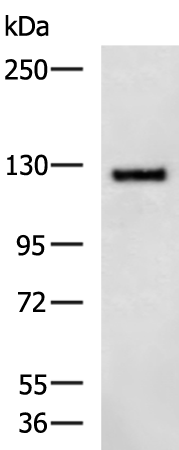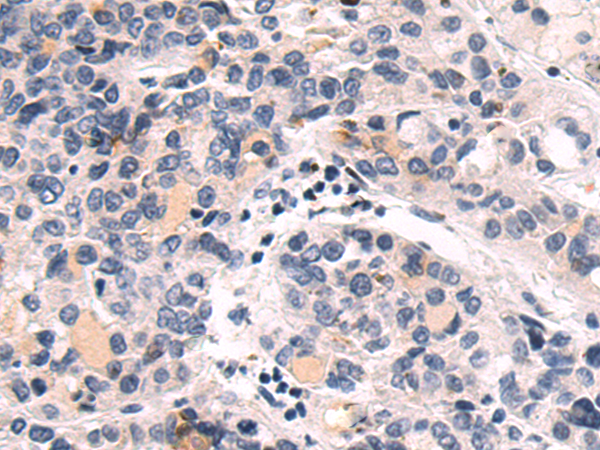

| WB | 咨询技术 | Human,Mouse,Rat |
| IF | 咨询技术 | Human,Mouse,Rat |
| IHC | 1/50-1/100 | Human,Mouse,Rat |
| ICC | 技术咨询 | Human,Mouse,Rat |
| FCM | 咨询技术 | Human,Mouse,Rat |
| Elisa | 1/5000-1/10000 | Human,Mouse,Rat |
| Aliases | GLI; PPD1; PAPA8 |
| WB Predicted band size | 118 kDa |
| Host/Isotype | Rabbit IgG |
| Antibody Type | Primary antibody |
| Storage | Store at 4°C short term. Aliquot and store at -20°C long term. Avoid freeze/thaw cycles. |
| Species Reactivity | Human, Mouse |
| Immunogen | Synthetic peptide of human GLI1 |
| Formulation | Purified antibody in PBS with 0.05% sodium azide and 50% glycerol. |
+ +
以下是关于GLI1抗体的3篇代表性文献,按作者、标题和摘要内容简要概括:
1. **作者**:Kasper M. et al.
**标题**:*GLI1 transcription factor in cancer: mechanisms and therapeutic potential*
**摘要**:本文综述了GLI1在多种癌症中的异常激活机制,并讨论了靶向GLI1的抗体在抑制肿瘤生长和转移中的应用潜力,包括抗体特异性验证和临床前研究结果。
2. **作者**:Lee J. et al.
**标题**:*Development of a monoclonal antibody targeting the C-terminal domain of GLI1 for Hedgehog pathway analysis*
**摘要**:研究团队开发了一种针对GLI1蛋白C端结构域的单克隆抗体,验证了其在免疫印迹(Western blot)和免疫组化(IHC)中的高特异性,为Hedgehog信号通路研究提供了可靠工具。
3. **作者**:Yang L. et al.
**标题**:*GLI1 antibody-based inhibition suppresses stemness in glioblastoma cells*
**摘要**:该研究利用GLI1抗体靶向抑制胶质母细胞瘤干细胞中的GLI1活性,证明其可显著降低肿瘤干细胞的自我更新能力,为靶向治疗提供了实验依据。
如需具体文献的DOI或发表年份,可进一步补充说明。
The GLI1 antibody is a crucial tool for studying the Hedgehog (Hh) signaling pathway, a key regulator of embryonic development, tissue homeostasis, and cancer. GLI1. a zinc finger transcription factor, acts as the primary effector of Hh signaling. It translocates to the nucleus to activate target genes involved in cell proliferation, survival, and differentiation. Dysregulation of GLI1 is linked to cancers like basal cell carcinoma, medulloblastoma, and glioblastoma, making it a biomarker and therapeutic target.
GLI1 antibodies are designed to detect endogenous GLI1 proteins in assays such as Western blotting, immunohistochemistry (IHC), and immunofluorescence (IF). They often target conserved regions, such as the C-terminal activation domain or N-terminal zinc finger motifs. Specificity varies between monoclonal (high specificity) and polyclonal (broad detection) versions. These antibodies aid in studying GLI1 expression patterns, nuclear localization, and post-translational modifications, providing insights into Hh pathway activation states.
In research, GLI1 antibodies help validate pathway inhibition by small molecules (e.g., SMO inhibitors) and assess tumor progression. Clinically, they support diagnostic profiling of Hh-driven cancers. However, cross-reactivity with other GLI family members (GLI2/3) requires careful validation. Overall, GLI1 antibodies are indispensable for unraveling Hh signaling mechanisms and developing targeted therapies.
×